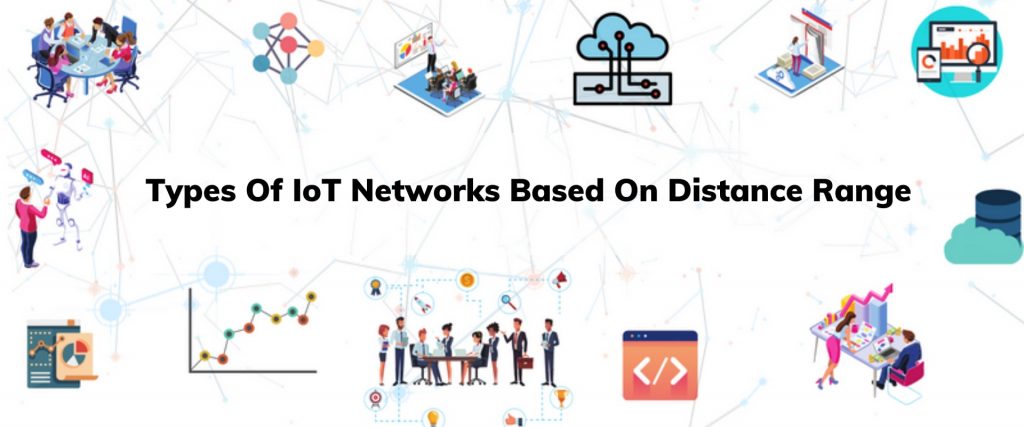Introduction to IoT Networks:
IoT Networks can be categorize as 9 different types based on their distance range. They are:
- Nano network
- NFC
- BAN
- PAN
- LAN
- CAN
- MAN
- WAN
- SAN
explanation of IoT Networks:
1. NANO NETWORK:
It is a type of connection that connects a set of small devices. The range is a few micrometres And thus these devices perform small talks like computing, storing, sensing and actuating. These Nano networks are in use in biometrical, military, and other nanotechnologies.
2. NFC NETWORK:
however, NFC stands for Near field communication. NFC only works within a very short range about 10cm maximum. It is a short-range wireless technology.
Working of NFC:
When two NFC enabled devices are thus very close to each other roughly around ~ 4cm. then they can communicate with each other using the radio waves. so To communicate one device has to be an active device like Smartphones, tablet, and another device can be either active or passive, an example of the passive device is NFC tag.
thus, Where active device means that a device which requires an external power supply, while the passive device doesn’t require any external power supply. NFC communicates using radio waves. These radio waves are generate using an antenna. This antenna is fix in Mobile battery or located at the backside of the back cover of Mobile.
This near field communication technology supports three more types of communication.
- Card emulsion mode of communication
- Peer-to-peer mode of communication
- Reader or writer mode communication.
Some applications of NFC technology are Google pay, Samsung pay, Apple pay.
3. BAN NETWORK:
BAN refers to a Body area network.
It is a short-range wireless network of wearable computing devices. These devices may be embed inside the system. BAN network can be describe as an extension of the wide-area network to personal space.
Body area network can categorize as:
- In-body communication: communication between the sensors inside a body.
- On-body communication: thus, communication between the sensors outside the body of a patient.
- Body- body communication: communication between sensors located one at a body and another at an antenna.
- Off-body communication: one sensor at the body and another at a fixed station.
hence, Examples of BAN networks are Wearables Ike smartwatches, fitness bands and wireless earphones that connects to the smartphone via Bluetooth.
Applications:
however, Ranging from healthcare and telemedicine Up to fitness and sports, tracking, interactive gaming, personal information sharing and authentication.
Technologies used:
- WiFi
- Zigbee
- Bluetooth
- IEEE 802.15.6
Among these technologies, Bluetooth is the most popularly used technology. While IEEE 802.15.6 is the latest addition to the list.
4. PAN NETWORK:
PAN refers to the personal area network. This type of network covers an area Up to one or two rooms. This type of network is used on a personal level. Devices like smartphones, tablets and laptops connect each other using wireless technologies such as Bluetooth, infrared and near field communication (NFC).
But they can also be connected by using a wired connection such as USB cables. Personal area networks generally used for transferring small files such as music, photos, calendar appointments and so on.
4. LAN NETWORK:
LAN abbreviated as a Local area network. It is a network of devices such as computers, servers, switches and printers that are located in the same building. Such as in an office or in a home.
Most widely used type of LAN is Ethernet LAN. Where two or more computers are connected to Ethernet cables using a switch. Now people use WLAN(wireless local area network) which uses wireless communication instead of wired communication.
6. CAN NETWORK:
CAN stands for campus area network. It is defined as a type of network which joins two or more LANs together within a short area. For example, CAN could be the institution that has multiple buildings on the same campus.
7. MAN NETWORK:
MAN refers to the Metropolitan area network and it is larger than CAN (campus area network) and it ranges over several buildings in a city.
They are connected using high-speed connections such as fibre optic cable that gives the ability to share data and resources within the city.
8. WAN NETWORK:
WAN stands for wide area network. It is the largest type of network. WAN includes multiple LANs, CANs and MANs. It is a network which spreads over a large geographical area such as a country, continent or even the entire globe.
A great example of WAN is INTERNET.
9. SAN NETWORK:
SAN means storage area network. Basically, it’s function is storing and providing access to large amounts of data. Basically, SAN is dedicated to storing data. One of the main reasons to use SAN is because SANs aren’t affected by network traffic such as bottlenecks that can happen in LAN.
CONCLUSION:
The Internet of Things has become the basic thing in digital transformation and automation, improving new business offerings and improving the way we live, work and entertain ourselves.
Choosing the suitable type of connectivity is a major part of any IoT Networks project.
Written by: Sameer
Reviewed by: Batta Pruthvi
If you are Interested In Machine Learning You Can Check Machine Learning Internship Program
Also Check Other Technical And Non Technical Internship Programs

